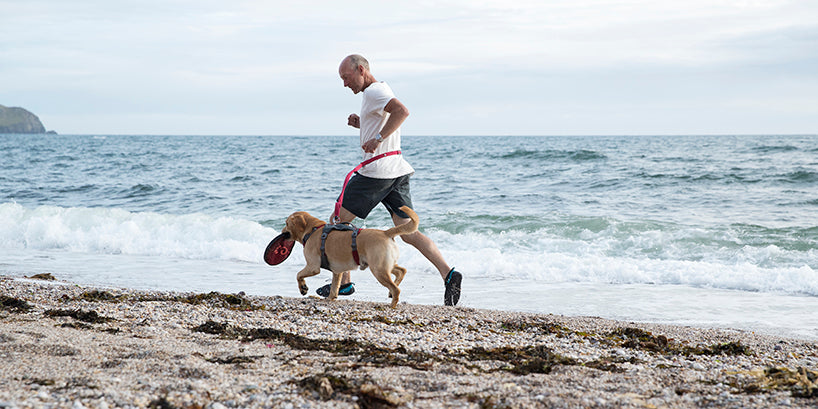Looking After Active Dogs and Canine Athletes From The Inside, Out
- Blog

Keeping your four-legged friend’s diet healthy and nutritious is vital as it means they can replenish energy lost in their healthy, active lifestyle.
What you should I feed my active dog?
The type of food your active dog needs depends on the type of exercise they do. For example, sled dogs need high levels of fat and protein; greyhounds require more carbohydrates. Moderately active pet dog’s diets should be somewhere in between, with a protein level of 22-32%, 30-55% high quality carbohydrate and 15-30% fat (all on a dry matter basis*).
Look for easily digestible food (determined by lower recommended feeding amounts and small amounts of stools being produced). Animal protein sources (chicken, fish or egg) are more digestible than vegetable protein sources (e.g. soya) and highly digestible carbohydrates include rice and potato. A diet of poorly digested ingredients means more will have to be eaten to get all the nutrients and energy needed, resulting in more faecal weight, which can slow dogs down.

Aiding healthy joints
Your dog’s joints also need to be looked after, so keep up a consistent exercise regime. Only walking at weekends and covering several miles in one day can lead to joint stiffness, so make sure they get out as often as possible throughout the week.
Overweight dogs carry more pressure on their joints, and some breeds are more susceptible to joint problems. If your dog seems to be moving stiffly/with a limp, is more tired/less interested in exercise than normal, they could be experiencing joint pain. If so, seek veterinary advice. However, supplements can help in some situations. For example, Omega 3 fatty acids from fish oil have anti-inflammatory properties and glucosamine and chondroitin can aid healthy joints.
Dog treats
Many dog treats are full of artificial flavours and additives. The best way to treat your dog in a healthy way is by giving them natural snacks (Vet’s Kitchen’s Little Stars Active+ treats are a good choice). Look for natural, high quality ingredients containing glucosamine, chondroitin and MSM for healthy joints, and also ones containing Omega 3 and 6 to maintain a healthy heart, skin and coat.
Every dog is different
While dogs come in all shapes and sizes, their needs can vary. For example, brachycephalic (flat faced) breeds can struggle to breathe and are often less exercise tolerant, which means they may only be able to manage shorter walks. Deep chested breeds can suffer from bloat and life-threatening gastric torsion, so it’s important not to feed them too soon before or after exercise.
Requirements also change depending on age. Puppies are naturally more active and grow quickly, so puppy food is recommended as it contains everything they need. Older dogs (7+ years) need food that is slightly lower in protein as their systems find it harder to digest. And don’t forget that young puppies and elderly dogs should have frequent spells of low impact exercise to protect their joints too.

Staying hydrated
As well as the correct food, water is also important. Even mild dehydration can have an adverse effect on dogs and their endurance ability, so a regular supply of fresh drinking water should always be available.
Be aware that hot and cold days require an increase in water consumption. So whatever the weather, make sure you have plenty of water with you on walks.
Feeding, exercising and what to avoid
Feed 4 hours before exercise and 1.5 - 2 hours after exercise to maintain normal blood sugar levels; feeding them immediately before or after strenuous activity can cause digestive problems such as diarrhoea. Also, where possible, use small amounts of high quality carbohydrate snacks and treats.
In the summer, the sun is at its hottest between 11am-3pm, so avoid walking/exercising your dog then.
Quality over quantity; look for high quality foods that label each ingredient by name (rather than vague mentions, like ‘cereals’).
Remember: it’s easy to increase food and treats when your dog is active, but it’s important to get the balance right. Active dogs don’t necessarily need more food; just the right kind.
Key takeaways
A healthy, balanced and nutritious diet, full of high quality ingredients, with some natural, low calorie treats every now and then. Remember that it’s quality over quantity in a diet that matters. To keep your four-legged friend healthy, just make sure you’re reading food packaging labels. And if in any doubt, consult your vet.
Vet’s Kitchen is an independent British pet food brand with an in-house vets practice who create food ideal for active dogs. Combining veterinary expertise and natural ingredients, their pet food promotes long-term health and wellbeing; just what your pet needs.
*To work out dry matter, look for the moisture content of the food. Dry food is usually about 8%. If moisture is 8% then the dry matter content is 92% (100-8 = 92). To work out the protein on a dry matter basis divide the protein level on the bag/tin of dog food by the dry matter content then multiply by 100. E.g. if the protein on the bag says 24% then: 24 ÷ 92 x 100 = 26%. The protein is 26% on a dry matter basis. The same technique can be used to determine the dry matter fat and carbohydrate content.



